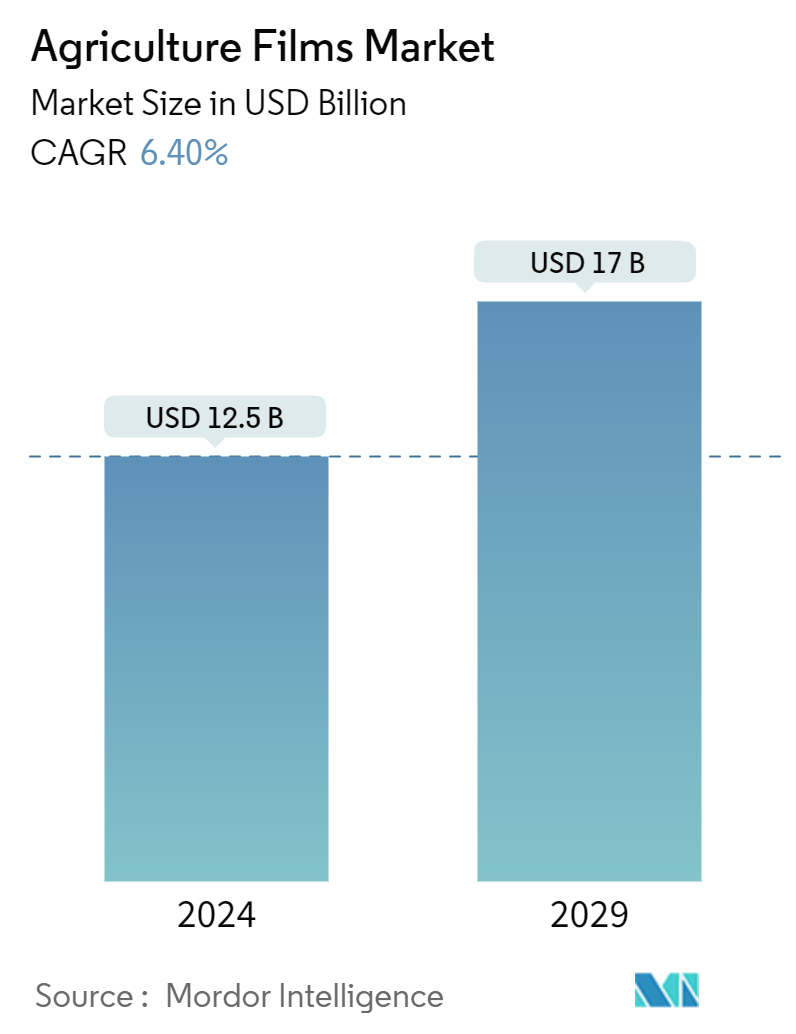Market Size of Agriculture Films Industry

| Study Period | 2019 - 2029 |
| Market Size (2024) | USD 12.5 Billion |
| Market Size (2029) | USD 17 Billion |
| CAGR (2024 - 2029) | 6.40 % |
| Fastest Growing Market | North America |
| Largest Market | Asia-Pacific |
| Market Concentration | Low |
Major Players
*Disclaimer: Major Players sorted in no particular order |
Agriculture Films Market Analysis
The Agriculture Films Market size is estimated at USD 12.5 billion in 2024, and is expected to reach USD 17 billion by 2029, at a CAGR of 6.40% during the forecast period (2024-2029).
Agricultural films are materials used extensively in farming for soil protection, greenhouse cultivation, and mulching. These films provide numerous benefits, including reduced soil erosion and compaction, temperature regulation, nutrient retention, improved seed germination, weed suppression, and protection against UV radiation. The agricultural film market is driven by several factors, including the increasing adoption of protected cultivation practices, a focus on enhancing crop yields, the widespread use of mulching films, and the growing demand for biodegradable options. Global food security concerns, stemming from a rising population and declining arable land, are further bolstering the demand for agricultural films as a means to improve agricultural productivity.
Mulching is a key application of agricultural films, with soil mulching using films becoming increasingly common in global agriculture. The growing consumer preference for biodegradable films, driven by environmental concerns, serves as a significant driver for this mature market. Mulch films are widely used in corn and soybean cultivation. Universities and researchers are actively studying ways to enhance the use of mulch films in agriculture, focusing on more sustainable solutions. In 2024, Lehigh University researchers developed biodegradable mulch films that deliver nutrients to crops, offering an environmentally friendly alternative to traditional plastic films. Additionally, the United States Department of Agriculture (USDA) and its National Institute of Food and Agriculture awarded a USD 744,000 research grant for a project titled "PARTNERSHIP: Engineering Nutrient-Enhanced Mulch Film to Improve Degradation and Soil Health." This multi-year initiative, running from July 2024 through June 2028, involves collaboration among experts from the University of Massachusetts Lowell, the USDA Agricultural Research Service in Maricopa, Arizona, and Ben Gurion University in Israel.
Agricultural films are widely used in various farming practices, including greenhouses and fodder packaging, to protect crops from cold temperatures. Canada's predominantly low temperatures due to long winters hinder crop growth, leading to a reliance on imports to meet demand. Consequently, the use of protected cultivation methods like greenhouses is increasing to reduce import dependency, driving the demand for greenhouse films. The area under greenhouse cultivation in Canada has been expanding for several years. According to the Ministry of Canada, in 2023, Canada had 920 commercial greenhouse vegetable operations, producing 802,163 metric tons of vegetables. This represented a 7% increase in production compared to 2022. Ontario remained the leader in the greenhouse vegetable market in 2023, accounting for 72% of Canada's total production. British Columbia followed with 14%, and Quebec with 8%. The remaining provinces collectively contributed 6% to the total production. This growth in the greenhouse industry is fueling the demand for greenhouse films in the market.
Environmental concerns are driving increased demand for biodegradable agricultural films. These eco-friendly alternatives help suppress weeds, regulate temperature, preserve soil nutrients and moisture, and enhance plant stability. Governments worldwide are promoting sustainable agriculture and eco-friendly farming practices, which is projected to support market growth in the coming years.
Agriculture Films Industry Segmentation
Agricultural films are used in many innovative agricultural practices to increase the crop output per hectare while enhancing crop quality. These practices include soil protection, greenhouse farming, controlled farming, and mulching. The agricultural films market is segmented by Type (Low-density polyethylene, Linear low-density polyethylene, High-density polyethylene, Ethyl vinyl acetate (EVA)/ethylene butyl acrylate (EBA), Reclaims, and Other Types), Application (Greenhouse, Silage, Mulching, and Other Applications), and Geography (North America, Europe, Asia-Pacific, South America, and Africa). The report offers market size and forecast in terms of values in USD for all the above segments.
| Type | |
| Low-Density Polyethylene | |
| Linear Low-Density Polyethylene | |
| High-Density Polyethylene | |
| Ethyl Vinyl Acetate (EVA)/Ethylene Butyl Acrylate (EBA) | |
| Reclaims | |
| Other Types (Polypropylene Agricultural Films, Polyamide Agricultural Films, Ethylene Vinyl-Alcohol Copolymer Resins, and PVC) |
| Application | |
| Greenhouse | |
| Silage | |
| Mulching |
| Geography | |||||||||
| |||||||||
| |||||||||
| |||||||||
| |||||||||
|
Agriculture Films Market Size Summary
The agricultural films market is experiencing significant growth, driven by the increasing adoption of protected cultivation practices and the need to enhance agricultural output. These films play a crucial role in improving agricultural productivity by offering benefits such as soil protection, temperature control, and weed suppression. The rising global population and diminishing arable land have heightened food security concerns, further fueling the demand for agricultural films. The market is also witnessing a shift towards biodegradable films, driven by environmental concerns and government initiatives promoting sustainable agriculture. These eco-friendly alternatives are gaining traction for their ability to preserve soil nutrients and moisture, regulate temperature, and enhance plant stability.
The Asia-Pacific region is a key driver of the agricultural films market, with a significant portion of the world's greenhouse vegetable cultivation occurring there. The region's focus on high-value and export-oriented cultivation, along with the thriving agriculture industry, supports market growth. The adoption of protected agricultural practices, particularly in countries like China, India, Japan, and South Korea, is enhancing crop productivity and quality. The market is characterized by fragmentation, with major players like Berry Global Inc., BASF SE, and Armando Alvarez Group investing in research and development to innovate biodegradable and longer-lasting products. These companies are also partnering with biotechnology firms to ensure sustainable product advancements, contributing to the market's positive outlook.
Agriculture Films Market Size - Table of Contents
-
1. MARKET DYNAMICS
-
1.1 Market Overview
-
1.2 Market Drivers
-
1.2.1 Increasing Harvested Area of Greenhouse Produce
-
1.2.2 Growing Use of Mulch Films in Agriculture
-
1.2.3 Innovations by Major Players
-
-
1.3 Market Restraints
-
1.3.1 High Initial Investment
-
1.3.2 Adverse Effects of Plastics on Environment
-
-
1.4 Porter's Five Forces Analysis
-
1.4.1 Bargaining Power of Suppliers
-
1.4.2 Bargaining Power of Buyers
-
1.4.3 Threat of New Entrants
-
1.4.4 Threat of Substitute Products
-
1.4.5 Intensity of Competitive Rivalry
-
-
-
2. MARKET SEGMENTATION
-
2.1 Type
-
2.1.1 Low-Density Polyethylene
-
2.1.2 Linear Low-Density Polyethylene
-
2.1.3 High-Density Polyethylene
-
2.1.4 Ethyl Vinyl Acetate (EVA)/Ethylene Butyl Acrylate (EBA)
-
2.1.5 Reclaims
-
2.1.6 Other Types (Polypropylene Agricultural Films, Polyamide Agricultural Films, Ethylene Vinyl-Alcohol Copolymer Resins, and PVC)
-
-
2.2 Application
-
2.2.1 Greenhouse
-
2.2.2 Silage
-
2.2.3 Mulching
-
-
2.3 Geography
-
2.3.1 North America
-
2.3.1.1 United States
-
2.3.1.2 Canada
-
2.3.1.3 Mexico
-
2.3.1.4 Rest of North Amercia
-
-
2.3.2 Europe
-
2.3.2.1 Germany
-
2.3.2.2 United Kingdom
-
2.3.2.3 France
-
2.3.2.4 Spain
-
2.3.2.5 Italy
-
2.3.2.6 Russia
-
2.3.2.7 Rest of Europe
-
-
2.3.3 Asia-Pacific
-
2.3.3.1 China
-
2.3.3.2 India
-
2.3.3.3 Australia
-
2.3.3.4 Japan
-
2.3.3.5 Rest of Asia-Pacific
-
-
2.3.4 South America
-
2.3.4.1 Brazil
-
2.3.4.2 Argentina
-
2.3.4.3 Rest of South America
-
-
2.3.5 Africa
-
2.3.5.1 South Africa
-
2.3.5.2 Egypt
-
2.3.5.3 Rest of Africa
-
-
-
Agriculture Films Market Size FAQs
How big is the Agriculture Films Market?
The Agriculture Films Market size is expected to reach USD 12.5 billion in 2024 and grow at a CAGR of 6.40% to reach USD 17 billion by 2029.
What is the current Agriculture Films Market size?
In 2024, the Agriculture Films Market size is expected to reach USD 12.5 billion.

